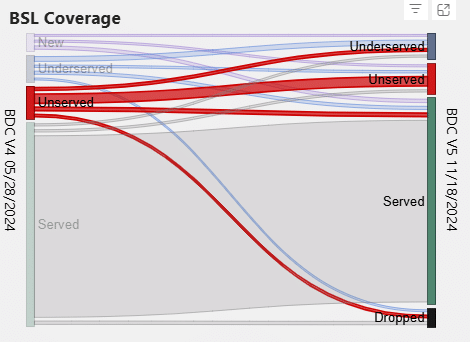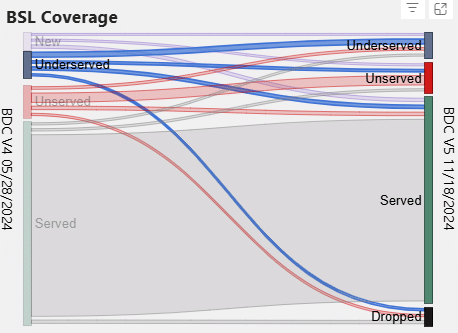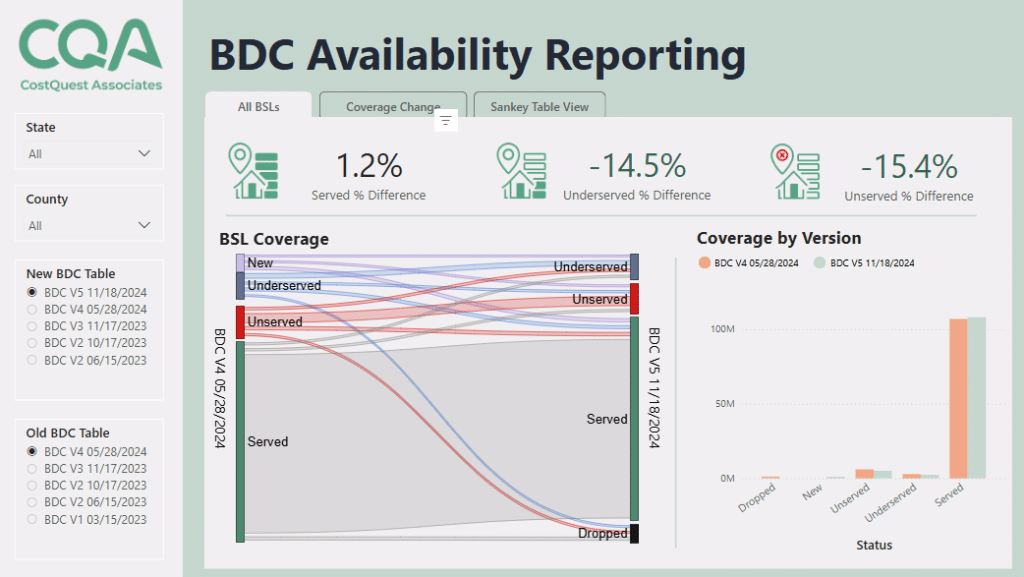The Broadband Serviceable Location Fabric and the Federal Communications Commission’s Broadband Data Collection (BDC) datasets are key tools for mapping broadband access and guiding critical funding distribution decisions across the U.S.
These two datasets are updated twice a year, and with the recent release of Location Fabric and BDC Version 5 in late 2024, the data continues to reflect the progress of the ongoing data improvements and broadband expansion efforts over a six-month period.
By combining the Location Fabric’s granular geospatial location data with ISP coverage reports, this data reporting system has proven to provide the granularity required to truly understand broadband access gaps by getting to the ground truth at the individual building structure level. Removing the “one size fits all approach” by mapping broadband availability at the census block level.
This reporting system continues to ensure that federal funding reaches the individual locations that need improved broadband access the most, and helps organizations be good stewards of public funding.
This article provides a comparative analysis of Version 5 (V5) and Version 4 (V4) of the Fabric and BDC Service Availability datasets, focusing on:
- Accuracy improvements in Location Fabric Version 5
- Changes between Fabric V5 and Fabric V4
- BDC service availability shifts, including reductions in unserved and underserved locations
- Distribution of federally funded and unfunded locations
Enhancements in Location Fabric Version 5
The Fabric Version 5 data introduces notable improvements in accurately identifying Broadband Serviceable Locations (BSLs), driven by refined data sources and advanced geospatial mapping methodologies.
Key Metrics for Fabric Version 5:
- Active Parcel Identification Accuracy: 99.5% of parcels correctly identified as containing a BSL.
- BSL Structure Identification Accuracy: 98.8% accuracy in pinpointing the precise structure(s) designated as BSLs within a parcel.
These enhancements result from integrating multiple high-quality data sources, including:
- Parcel records
- Satellite imagery
- Building footprints
- Tax assessments
- Address databases
Along with other additional data sources to help us better determine parcels with BSLs, and identify the BSL structure or structures on a parcel.
Our methodology incorporates algorithms, AI, and managed crowdsourcing to improve precision in identifying structures that require broadband service.
Changes in Location Fabric Version 5 Data
The total number of BSLs in Fabric Version 5 has undergone a marginal decrease compared to the previous version:
- Fabric Version 5 (V5): 115.6 million BSLs
- Fabric Version 4 (V4): 115.7 million BSLs
This decrease is attributed to refinements in data verification, structure identification improvements, and the results from the FCC’s Location Challenge Process.
BDC Version 5 Unserved & Underserved Coverage Changes
The BDC Version 5 dataset indicates a reduction in unserved and underserved BSLs, reflecting ongoing broadband expansion efforts and refinements in the reported coverage data.
Key Changes from V4 to V5:
- Unserved Locations decreased from 6.1 million (V4) to 5.1 million (V5)

- Underserved Locations decreased from 2.8 million (V4) to 2.5 million (V5)

Version 5 Federally Funded & Remaining Unfunded Locations
The Fabric, BDC, and Federal Funding Version 5 data provide updated insights into locations supported by federal funding programs and those that remain unfunded.
Approximately 2.5 million BSLs are covered under federal subsidy programs, including:
- Enhanced Alternative Connect America Model (E-ACAM)
- Rural Digital Opportunity Fund (RDOF)
- Connect America Fund Phase II (CAF II)
There are 5.08 million BSLs remaining eligible for BEAD (Broadband Equity, Access, and Deployment) funding. These locations represent areas that still require investment to close broadband accessibility gaps.
How to Access the Location Fabric & BDC Version 5 Data
You can explore the high-level BDC Service Availability data comparisons through CostQuest’s BDC Service Availability Comparison Dashboard.
Or you can get a Commercial Broadband Fabric or OnLook license to access and download the granular data.

Location Fabric & BDC Version 5 vs. Version 4 Dataset Details
Below are the dates each Version of the Fabric and BDC data represents.
Version 5 – Data as of June 30, 2024
- Fabric Locations: Released on June 30, 2024
- BDC Service Availability Data (ISP coverage): As of June 30, 2024
Version 4 – Data as of December 31, 2023
- Fabric Locations: Released on December 31, 2023
- BDC Service Availability Data (ISP coverage): As of December 31, 2023
Disclaimer
This communication does not reflect the opinion of the National Telecommunications and Information Administration (NTIA) and Federal Communications Commission (FCC). The NTIA and FCC are not responsible for the information or views in this communication and are not responsible for the accuracy, completeness, or timeliness of such information or views.